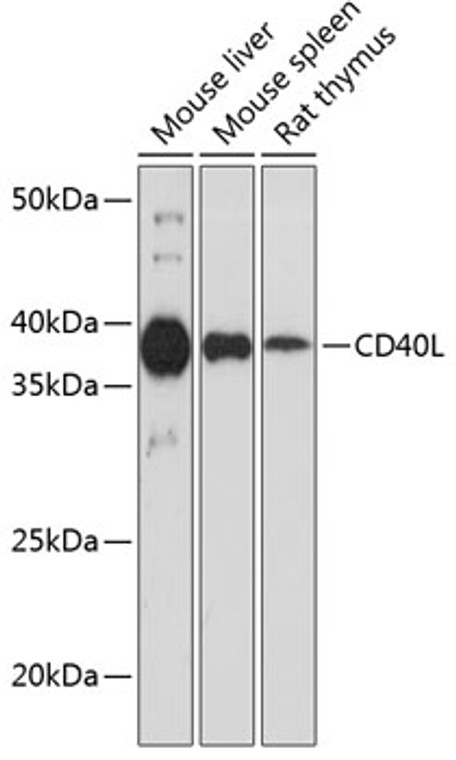| Host: |
Rabbit |
| Applications: |
WB |
| Reactivity: |
Mouse/Rat |
| Note: |
STRICTLY FOR FURTHER SCIENTIFIC RESEARCH USE ONLY (RUO). MUST NOT TO BE USED IN DIAGNOSTIC OR THERAPEUTIC APPLICATIONS. |
| Short Description: |
Rabbit monoclonal antibody anti-CD40L (50-150) is suitable for use in Western Blot research applications. |
| Clonality: |
Monoclonal |
| Clone ID: |
S7MR |
| Conjugation: |
Unconjugated |
| Isotype: |
IgG |
| Formulation: |
PBS with 0.02% Sodium Azide, 0.05% BSA, 50% Glycerol, pH7.3. |
| Purification: |
Affinity purification |
| Dilution Range: |
WB 1:500-1:1000 |
| Storage Instruction: |
Store at-20°C for up to 1 year from the date of receipt, and avoid repeat freeze-thaw cycles. |
| Gene Symbol: |
CD40LG |
| Gene ID: |
959 |
| Uniprot ID: |
CD40L_HUMAN |
| Immunogen Region: |
50-150 |
| Immunogen: |
A synthetic peptide corresponding to a sequence within amino acids 50-150 of human CD40L (P29965). |
| Immunogen Sequence: |
LDKIEDERNLHEDFVFMKTI QRCNTGERSLSLLNCEEIKS QFEGFVKDIMLNKEETKKEN SFEMQKGDQNPQIAAHVISE ASSKTTSVLQWAEKGYYTMS N |
| Tissue Specificity | Specifically expressed on activated CD4+ T-lymphocytes. |
| Post Translational Modifications | The soluble form derives from the membrane form by proteolytic processing. N-linked glycan is a mixture of high mannose and complex type. Glycan structure does not influence binding affinity to CD40. Not O-glycosylated. |
| Function | Cytokine that acts as a ligand to CD40/TNFRSF5. Costimulates T-cell proliferation and cytokine production. Its cross-linking on T-cells generates a costimulatory signal which enhances the production of IL4 and IL10 in conjunction with the TCR/CD3 ligation and CD28 costimulation. Induces the activation of NF-kappa-B. Induces the activation of kinases MAPK8 and PAK2 in T-cells. Induces tyrosine phosphorylation of isoform 3 of CD28. Mediates B-cell proliferation in the absence of co-stimulus as well as IgE production in the presence of IL4. Involved in immunoglobulin class switching. CD40 ligand, soluble form: Acts as a ligand for integrins, specifically ITGA5:ITGB1 and ITGAV:ITGB3.both integrins and the CD40 receptor are required for activation of CD40-CD40LG signaling, which have cell-type dependent effects, such as B-cell activation, NF-kappa-B signaling and anti-apoptotic signaling. |
| Protein Name | Cd40 LigandCd40-LT-Cell Antigen Gp39Tnf-Related Activation ProteinTrapTumor Necrosis Factor Ligand Superfamily Member 5Cd Antigen Cd154 Cleaved Into - Cd40 Ligand - Membrane Form - Cd40 Ligand - Soluble FormScd40l |
| Database Links | Reactome: R-HSA-198933Reactome: R-HSA-5668541Reactome: R-HSA-5676594 |
| Cellular Localisation | Cell MembraneSingle-Pass Type Ii Membrane ProteinCell SurfaceCd40 LigandSoluble Form: SecretedRelease Of Soluble Cd40l From Platelets Is Partially Regulated By Gp Iib/IiiaActin PolymerizationAnd A Matrix Metalloproteinases (Mmp) Inhibitor-Sensitive Pathway |
| Alternative Antibody Names | Anti-Cd40 Ligand antibodyAnti-Cd40-L antibodyAnti-T-Cell Antigen Gp39 antibodyAnti-Tnf-Related Activation Protein antibodyAnti-Trap antibodyAnti-Tumor Necrosis Factor Ligand Superfamily Member 5 antibodyAnti-Cd Antigen Cd154 Cleaved Into - Cd40 Ligand - Membrane Form - Cd40 Ligand - Soluble Form antibodyAnti-Scd40l antibodyAnti-CD40LG antibodyAnti-CD40L antibodyAnti-TNFSF5 antibodyAnti-TRAP antibody |
Information sourced from Uniprot.org
12 months for antibodies. 6 months for ELISA Kits. Please see website T&Cs for further guidance







